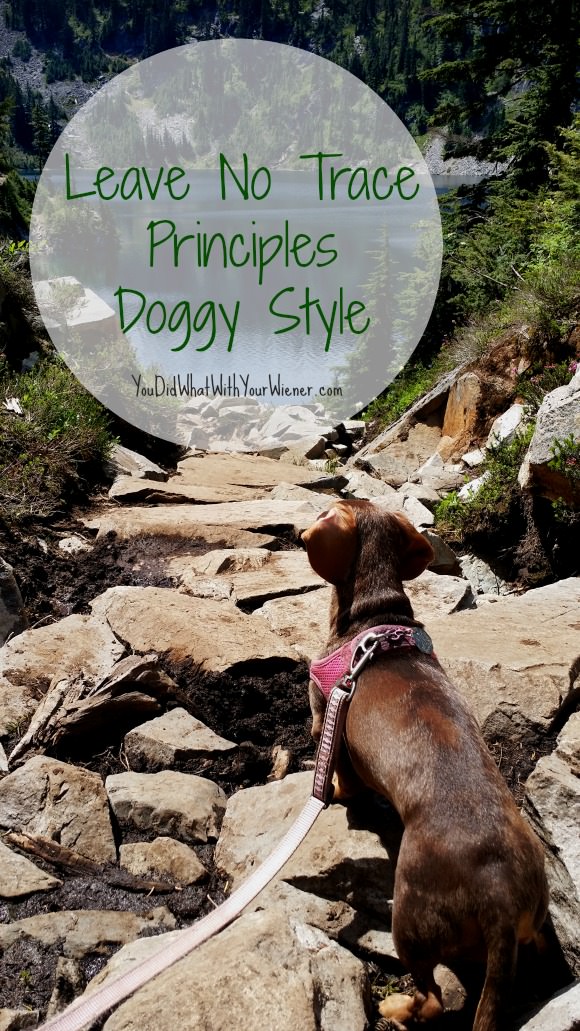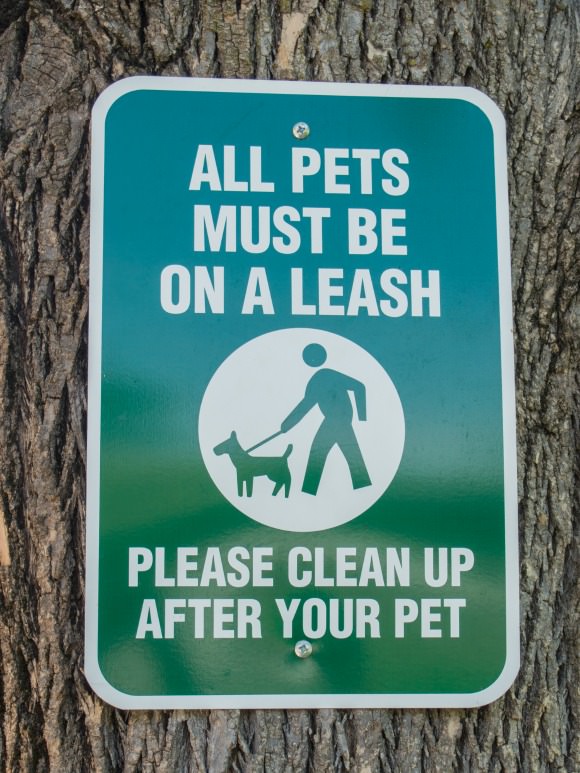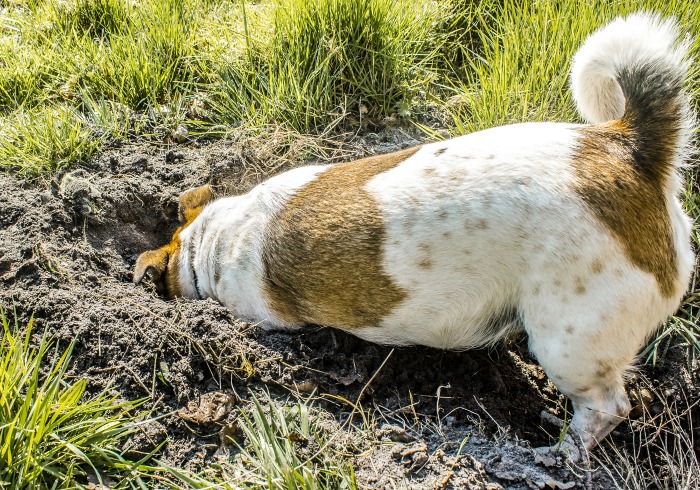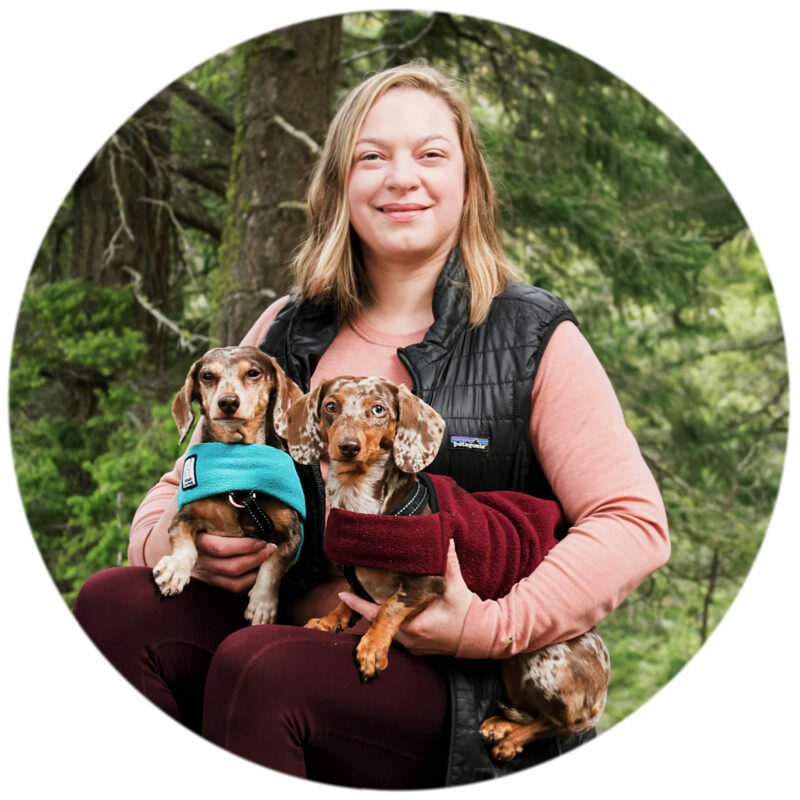A Guide to Leave No Trace Principles for Your Dog
With many – hundreds in some cases – people and dogs using the same trails and parks, they can have quite an impact on the environment.
In 1990, the United States Forest Service, in conjunction with the National Outdoor Leadership School (NOLS), developed a set of outdoor ethics promoting conservation in the outdoors.
The aim of these guidelines were keeping wild areas in as close to their natural state as possible, thus preserving natural recreation areas for generation to come.
Most outdoor enthusiasts have heard of the Leave No Trace principles and are pretty good at following the principles themselves.
However, many people that hike with dogs don’t often think about the impact their furry hiking companions can have on the environment.

Dogs Negatively Impact the Environment Too
A dog can have just as much, or more, of an impact on vegetation, wildlife and nature as humans can.
Some people see their dog as “just another wild animal” out in the woods but the number of domesticated dogs using on trails in a lot of areas is much greater than the number of wildlife in any given area.
Also, wild animals have adapted to survive and thrive in natural environments without disrupting the ecosystem.
Dogs can trample vegetation and poop is produced in a higher rate and amount than the environment can naturally handle.
Reduced vegetation leads to erosion and pet waste can wash into lakes and streams, polluting it with bacteria and potentially making people and wildlife who drink it sick.
Therefore, it’s just as important that dogs follow leave no trace principles too (or rather, that you insure your dog does).
Enter the guide to leave no trace policies for dogs.
A Guide to Leave No Trace Hiking With a Dog
I worked for a National Park for 8 seasons, worked as an environmental scientist for another 10, and have been hiking with my dogs for 20 years, so I’m really well-versed in environmental protection practices.
I’ve adapted all of the leave no trace rules so that they are relevant for dogs.
1. Plan ahead and prepare
Research any new trails or parks you are planning to visit and know the regulations regarding dogs.
Some areas, like most National Parks, don’t let dogs on trails. Some other areas, like wildlife preserves, might not let dogs inside their boundaries at all.
Also know the leash requirements.
A lot of places require dogs be on a leash that is no longer than 6 feet, some allow you to use “voice control” and hike with your dog off leash, and a few don’t have any restrictions at all.
These rules are meant to protect wildlife and vegetation so know what they are and follow them.

2. Dispose of pet waste properly
Pet waste can make wildlife and people sick. In Glacier National Park, Montana, parvovirus was spread from dogs to wolf-pup populations leading to death amongst the wolves (Source).
The default practice is to pick up your dog’s waste and pack it out.
It’s true that carrying poop bags in your backpack can get smelly but it doesn’t have to be that way.
Placing the poop bag inside of a smell-proof Ziplock bag, like a Smelly Proof Storage Bag, will take care of that.
If you are hiking for multiple days and can’t pack the waste out, bury it in a cathole dug 6 to 8 inches deep, located at least 200 feet from water, camp and trails.
Be sure to cover and disguise the hole when finished.

3. Travel and camp on durable surfaces
Just as people, dogs should always stay on the trail.
If they are allowed to wander off, they will trample the vegetation, or do worse like dig holes that uproot plants and disturb wildlife habitat.
You also can’t keep track of where you pet is “leaving their deposits” and be mindful of scooping the poop if they go off trail.
At camp, place a dog bed where you want them to lay when they are not inside of the tent.
Also, it’s best to keep your dog from bathing and playing in lakes and streams.
Their activity stirs up mud and dirt that can destroy the living and mating habitat of fish and other aquatic creatures.
4. Leave what you find
Don’t let your dog pick up large sticks or rocks and carry them away.
You never know if that boring stick or grey rock is part of a cultural site or a rooftop to a critter’s home.
5. Minimize campfire impacts
Your dog won’t be building a fire, of course, but you might be building one to keep them warm.
You can eliminate the need for a fire all together by bringing a warm jacket for fido.
If you do have to build one, only collect downed wood for fuel and make sure it is 100% out before you leave camp.

6. Respect wildlife
As tempting as it may be for your dog, and as “cute” as it may seem to watch, don’t let your dog chase or harass wildlife.
According to the National Park Service, wildlife will become used to a human or horse being present in its’ territory, but not a dog.
Your dog might disrupt them during a crucial time like mating season, when they are with their young, or while they are gathering food for the winter.
Protecting wildlife also means properly storing your pet’s food so wildlife doesn’t get habituated to eating “junk food”.
Be sure to securely store your pet’s food with yours and don’t leave food out in their dish overnight.
7. Be considerate of other visitors
Believe it or not, not all people like or are comfortable around dogs.
A person might be allergic or might have had a bad experience with a dog in the past.
Even people who like dogs usually don’t appreciate a strange dog bounding up to them on the trail.
The idea here is to enjoy a day on the trail with your dog without impacting other’s enjoyment of the outdoors.
A few simple dog hiking etiquette tips include:
- Preventing your dog from running up to strangers on the trail
- Wandering from group to group begging for food at popular lunch spots
- Or creating “noise pollution” by barking excessively.
Final Thoughts
Practicing Leave No Trace principles is about making good decisions to protect and preserve the world around you – the world we all enjoy – and so that others can enjoy it as much as you do.
It’s not about taking the fun out of things.
Instead, it’s about having fun with your dog in a responsible way so that others coming after you can appreciate their natural surroundings in the same way that you are.
Want to Know More About How You Can Leave No Trace?
- Read This! 7 Leave No Trace Fails and Remedies

About the Author
Hi, I’m Jessica. I’ve been studying the Dachshund breed since 2007, owned 3 of my own, and shared in the lives of thousands of others through their owner’s stories. When I’m not sharing what I know on this blog, you can find me hiking, camping, and traveling with my adventurous wiener dogs.

All good advice but #4 is one that not everyone thinks about.
Exactly why I mentioned it here 🙂 My Mom taught be not to disturb rocks on the beach when I was a kid because it disturbs the habitat of little creatures. I am not sure I’ve ran into anyone since then that thinks there is any kind of problem with moving rocks and sticks. Number 4 is a possibility every time something is disturbed. I’ll admit I did pick up rocks on the beach sometimes anyway. Half of the time I put them back in place like my Mom said and other times I didn’t. I guess the goal here is to pay attention to this kind of things more times than not. Nobody is perfect 🙂
#1 really resonates. So many people let their dogs off leash in a leash only area. They think they can control their dogs but they never can.
I’ve seen some that can but it’s rare. Some dogs may listen at home but can often get over stimulated on the trail and “lose their hearing”. Another common thing I see is that people don’t understand what strict voice control means. They think it means that whatever their dog does is ok as long as they come back after being called two or three times. What it really means is that your dog sticks close by your side and immediately stops what it’s doing to return to you the first time you call it. This is a hotly debated subject that will rage on and on though.
What a great article. Picking up the poo is just natural for me at this point, but it makes it seem kinda noble when considering the negative impact is not just limited to the next hiker’s boots. Also, on the leash tip. One of my little ones is ultra aggressive and she’s always on a leash but when another dogs runs up to her unleashed there’s sure to be a fight if I can’t grab her before the dog arrives. I think a lot of people don’t think of it in that way.
Yes, you are right, most people don’t think of it that way. My dogs are always on a leash and when a dog is coming, on leash or off, we step aside and I stand between them and the other dogs. Other leashed dogs go on by with no problems. I’ve had off leash dogs aggressively try and push they way through me to Chester and Gretel and, invariably, Chester and Gretel go nuts. I’ve actually had people accuse me of having aggressive dogs when they do that! The nerve of some people. They are just clueless and I find that frustrating and sad at the same time.